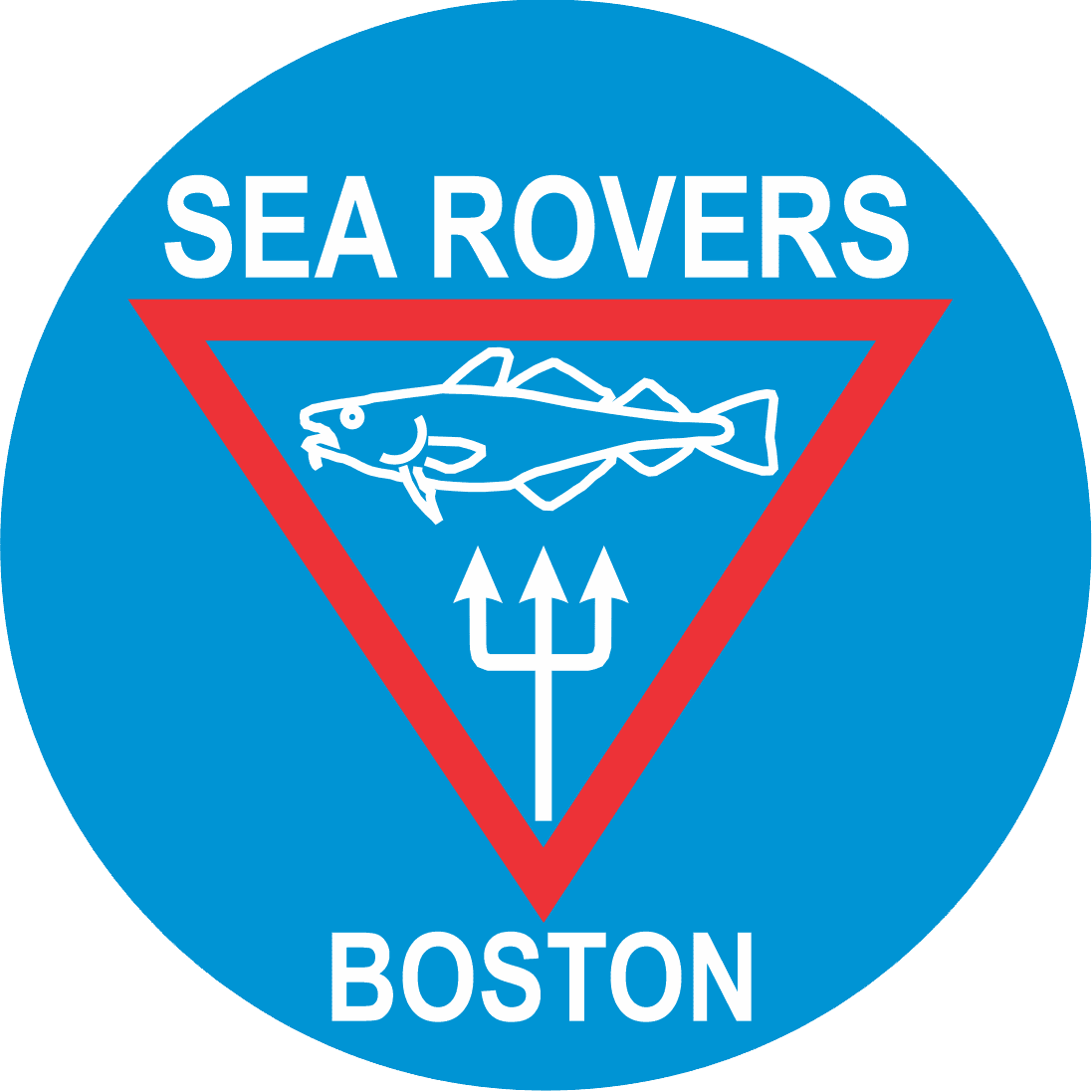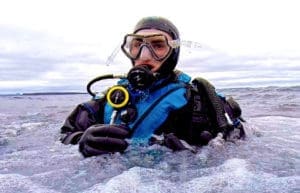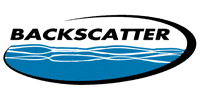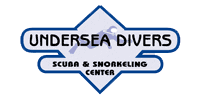Moving Search and Rescue/Recovery
Moving-water dives present significant hazards for which most PSD teams are prepared. What is the maximum current you can dive from shore? From a platform? Can you just send a safety-diver down a needy primary-diver’s line? Learn about hard-hitting issues that will help you stay alive and search effectively.
Ice Diving Search and Rescue/Recovery
Sadly, most PSD teams are trained with recreational procedures involving supportive ice. Yet, if a victim falls through, the ice is unsupportive. Divers cannot walk, crawl, stand or sit. It is time to use real world SARR ice procedures so that more victims can be saved and more rescuers go home.
Breathing Underwater
Proper breathing is the foundation of safe and enjoyable diving. Find out why we should not do deep breathing on scuba and why we should maintain normal tidal volume breathing with exhalations 2-3 times longer than inhalations. Proper breathing will significantly drop air consumption, will allow you to shed lead, and will provide a strong basis for smooth and efficient underwater movement.
Ultimate Underwater Movement
Hovering is equivalent to a toddler learning how to walk. Ultimate underwater movement means gracefully skimming inches away from a reef without touching anything. Move as efficiently and smoothly as fish so you can school with them. Rotate into any position with no depth changes. Hold yourself in place in current without contacting anything, even with your head downstream. Ultimate underwater movement even allows you to swing dance on scuba.
THE PHILIPPINES – The Apex of the Coral Triangle
This presentation covers 6 different areas of the Philippines – Apo Island, which
is the model sanctuary for the world; Tubbataha, the 1st UNESCO World Heritage
Marine Park site; Donsol, the whale shark capital of the world; S. Leyte, noted for
whale sharks; Anilao, being called the center of marine diversity; and Puerto
Galera known for its many critters & The Canyons.
Eastport & Deer Island — World Class Diving in Our Own Backyard
Eastport, Maine and its neighbor across the bay, Deer Island, are home to some of the best diving anywhere. With countless anemones, sponges, nudibranchs and other inverts, and just as many fish, the life and color is breathtaking. Come on a photographic look at these two incredible sites — both within driving distance of Boston.
Pushing the Envelope: Northeast Diving Alternatives
Sure we have some good shore diving. Certainly we have some of the very best shipwreck diving in the world. But what else is there for Northeast Divers? For divers new to the sport as well as jaded veterans, there are plenty of interesting ways to keep active in the sport we love. Join Eco-Photo Explorers as they examine some exciting and adventurous diving alternatives available to all of us. You may be surprised at what’s possible right here in our own backyard!
Frozen Fins: The Art and Science of Ice Diving
When the weather turns cold and the local waters turn to ice, many divers pack up their dive gear and wait for the return of summer. Some hasten its arrival with a trip to warmer climates while winter maintains its grip on the north. But the arrival of winter does not need to mean the end of local diving. In this program, you will learn the techniques, equipment requirements and reasons for safely venturing below the ice in one of diving’s most challenging, and rewarding, activities: Ice Diving. Join Eco-Photo Explorers as they explain the “hows” and “whys” of ice diving and introduce you to some of the best places to dive beneath the ice.
Curacao, the Caribbean’s Desert Island
Curacao, an arid Caribbean island located just off the northern coast of Venezuela, boasts some of the best diving in the Caribbean. Divers can explore healthy reefs teeming with marine life and iconic shipwrecks rich in history and character, and photographers will revel in the gin-clear water that washes over the drop-offs from deeper water. All this and you can still be back in time for lunch with the family! This presentation introduces you to one of the most colorful islands in the Caribbean.
Bonne Terre: Deep Earth Diving
Massive underground caverns and mammoth architecture. The sunken remains of a working mineral mine, complete with equipment, rail tracks, ore carts, elevator shafts and even intact buildings. A billion gallon underground lake with crystal clear water and constant temperatures year round. And miles of underwater trails to explore. Bonne Terre is an adventure for all divers and its right here in our own backyard. Located just 40 minutes south of St. Louis in the foothills of the Ozark Mountains, Bonne Terre is a unique diving experience that will capture your imagination and beckon you back for more. It is truly like a “Dive to the Center of the Earth.” Join Eco-photo Explorers as they journey below ground to explore the underwater treasure that is Bonne Terre.
Maldives: Resort Diving in Paradise
The Maldives have long held a spot on many diver bucket lists. With picture-perfect beaches, remote island atolls and spectacular diving, the attraction is understandable. Many divers come to the Maldives looking for Liveaboard adventures. This program explores an alternative approach: luxury diving from land based resorts. Join Eco-Photo Explorers as they explore the magnificent world beneath the tropical seas of the Maldives, with just a small dash of decadence thrown in!
Diving the Very Best of Indonesia by Live-Aboard
We’ll show the audience that Indonesia diving is as easy-as-Cayman diving (almost), incredibly bio-diverse, and that the live-aboard is really the best way to go if you want to maximize your diving experience throughout this 4,000 mile wide region . Using footage shot and edited by the speaker, we will show charts, routes and outstanding underwater footage made easily from live-aboard dive boats. Big cameras-no problems! The live-aboard crews and access make big camera image-making a snap. How does a diver gain access to both the most unusual muck-diving critters and the most gorgeous and healthy coral gardens in a single trip? Try a live-aboard in Indonesia!
A Sea That Time Forgot
Remote and undiscovered by the 21st century, the Forgotten Islands of Indonesia are home to pristine coral reefs and a people who have never before seen white faces.
Imagine a land lost in time, forgotten by Westerners for hundreds of years. A land inaccessible eleven months of the year and so remote a passing ship is both a strange and celebrated sight. With only charts and ideas of prevailing winds and currents, Nancy explores this unique and never before dived area of the southeastern Banda Sea.
An Anthology of rare underwater images as seen through the eyes of 30 divers from professional to amateurs
Sensational Seas Two anthology presents underwater images as seen through the eyes of divers, from distinguished scientists and seasoned professionals to talented amateurs. In fascinating footage the ocean opens up: we hear the songs of humpback whales, feel the fear prey does for predator, see through the eyes of a bird as it hunts beneath the waves. Sensational Seas will evoke the thrills of diving − those priceless moments when you want to yell WOW into your regulator!
Can you reach the Mariana Trench for under $100?
Current underwater robotic technology allows for deep ocean research (6+ miles), but the cost and size of these devices restricts their use to large-scale research facilities and companies. Presented here is a new project to create extremely low-cost (<$100) autonomous underwater vehicles that are capable of full ocean depth.
Aircraft wrecks of Truk Lagoon
Truk Lagoon has long been famous for its number of shipwrecks and naval history, but the abundance of airplane wrecks and airplane parts inside shipwrecks is overlooked. In this presentation we will explore these aircraft wrecks, their specific stories, as well as examine the array of aircraft parts that make up so much of the cargo in Truk’s shipwrecks.
Freediving with Speed: F3F
This presentation discusses a new freediving event, Formula3Freediving. This scooter racing event pits teams of three divers against one another in adrenaline-pumping underwater races, where divers use DiveXtra Cuda scooters, which reach speeds upwards of 600 feet/minute. Tracks include wrecks, slaloms and rally races. I’ll also show videos outlining the races from the Cayman Grand Prix in 2011
The Art of Freediving
This presentation will discuss freediving as a whole, including the dangers of blackout and safety techniques divers can adopt to reduce their risk. It will also discuss recreational training, competitions and record dives, including videos. It gives a good general overview of freediving and gives tips to increase freediving safety.
Lessons learned
The dive missions from through out Massachusetts and other states from the year 2011
NESPAC training for NIMS Type 1 Dive teams
The New England state police agencies are training together with a 5 week training school to bring all new divers up to the same level required for the base level as NIMS type 1 dive teams. The N.E. State Police dive units are Coordinating training, equipment, and ideas. We are using ERDI /TDI training agency to assist in developing this program. The first class was started in September of 2011 and other classes starting in 2012. This along with the states engaging in joint missions and inservice training will complete a a team of 120 divers through out New England and New York to cover major events and assist with expertise on specialized missions.
2 Manta Ray of Hope
Manta rays are increasingly and unsustainably targeted for their gills, depleting many regional populations, internationally. Shark Savers and WildAid developed the Manta Ray of Hope Project (http://mantarayofhope.com/) to collaborate, world-wide, with leading manta researchers, NGO’s, governments and local communities to produce the first global status report, support trade bans, establish sanctuaries, increase consumer education and raise awareness, and develop ecotourism in select fishing communities.
SharksCount – Citizen Science for Sharks: “Divers counting sharks, because every shark counts.”
Shark Savers works to improve protections for sharks. Often, doing so, requires data about local populations; but such information is frequently absent or missing. Divers, who see sharks regularly and are often familiar with local trends, rarely have the training to accurately and consistently record these valuable sightings for shark conservation advocacy. SharksCount (http://www.sharksavers.org/sharkscount) seeks to close an important data gap by empowering divers with the knowledge and simple, fun tools to participate as “citizen scientists for sharks”.
Sharks of New England
Joe Romeiro will screen footage and discuss filming techniques from some of his latest East Coast dive adventures with Basking sharks, Makos, Blues, and other sharks of New England.
Whale Sharks in The Kingdom
In 2009, we discovered a previously unknown aggregation of whale sharks in the Saudi Arabian Red Sea. Since then, we have tagged over 60 individuals – making this the largest, most intensive whale shark high-tech tagging program in the world. This presentation presents the first results of this research.
Three’s a Charm: A Casualty of the 1938 Hurricane?
On September 21st, 1938 a category three hurricane struck the woefully unprepared and ill informed New England coast. This powerful storm claimed the lives of 682 people and 5974 vessels were lost, damaged, or destroyed. In this presentation we will explore the discovery of a shipwreck, located off the Connecticut coast within Fishers Island Sound, which was previously unknown and has yet to be identified. Is she, as the evidence would suggest, a casualty of the hurricane dubbed the “Long Island Express?”
The Path of the Black Diamond; Exploring the “Smudge Wrecks” of Block Island Sound
Seven coal-laden shipwrecks in Block Island Sound were located and explored in 2011 by Mark Munro and his dive team. Each appeared as little more than a “smudge” on sonar records causing them to be dubbed, “smudge wrecks.” Join Mark as he discusses his new findings and presents a one-hundred year perspective on coal transportation along the East Coast.
“Are You Really Ready to Dive?”
This presentation involves a review of DAN data on diving injuries and fatalities and the role equipment plays in diving emergencies. The presentation also contains candid photos of divers using or misusing equipment with discussions of how to reduce or mitigate diving risks due to equipment configuration and use errors.
The Art of Blackwater Searching
Want to find a gun in a silty blackwater bottom covered with debris or find a drowning victim in 15 feet of grass in zero vis? Learn tricks of the trade to safely perform solo-tethered-tender-directed searches, with divers using both hands to search, and not cutting their efficiency in half by keeping one hand on their line. Learn five procedures to prove that the item was not there, not that the dive team missed it.
The Ghost of the Rhone
There are shipwrecks and Shipwrecks. Michel and Danielle share with us the story of what they call: “The quintessential shipwreck.” Join them for an exploration of this XIX century ship that met its fate during one of the worst hurricanes ever to hit the Caribbean.
The Life…The Death …The Reincarnation of the SS NORTHERN PACIFIC
This is a ship wreck off of New Jersey-Delaware Coast. This wreck had a great part of WW1and the Troops and The FIRST ARMISTICE..
Success! Reversing Extinction for the Pacific Leatherback Turtle
Seven years of conservation efforts on the very remote beaches in Indonesia have led us to formulating methods to reverse the extinction threats for this highly endangered species. Dr. McKenna will also discuss lessons learned in forming and operating a non-profit foundation.
The Japanese Garden of Hawaii
Diving Hawaii is a dream for many and a question mark for others. Our speakers spent 4 weeks on the Big Island and, between the volcanoes, mountain tops and Aggressor fleet’s own vision, they found the answer to the question that bugged them for many years: Is diving any good in Hawaii?
THE BRIDGE – The remarkable macro life under the Blue Heron bridge in Florida
A documentary on the remarkable macro life under the Blue Heron bridge just north of WestPalm Beach, Florida. It is World Class and right in our national back yard.
Coron – Macro Mecca of the Philippines
As a celebrity delegate to the inaugural Philippine Dive Seafari, Paul Cater Deaton explores Coron, on the island of Palawan. Coron is rich in history and tradition, and home to some of the friendliest people on Earth. The film reveals Filipinos devoted to fostering sustainable eco-tourism in this hotspot of biodiversity, and establishing their islands as a macro Mecca. Completely encompassed within the Coral Triangle, the Philippines are part of the richest aggregation of marine life on the planet.
Diving and Exploring the Frozen Frontier Alaska to British Columbia via the inside passage
Through his underwater photography company Handlerphoto, Mauricio Handler leads photographic workshops and expeditions around the world both to warm and cold water destinations. One of his most memorable adventures took place last year as he traveled back into a time of less hurried exploration aboard a 100-year-old converted tugboat. The journey from Vancouver, British Columbia to Alaska via the inside passage was a change of pace for this adrenalin junkie.
From certified to certifiable. From photographing in warm tropical seas to an almost obsessive passion for image making in cold-green waters
Since first being certified in 1978 professional underwater photographer Mauricio Handler has been diving and photographing in warm waters.
Just a few years ago though, he jumped into the cold and is now a confessed addict to this new cold and for the most part green environments. It has changed the focus of his work and invigorated his imagery, in the process questioning his sanity!
Succeeding as a professional underwater photographer in today’s economy. Be prepared to re-invent yourself, often!
It is no secret that earning a living as a professional underwater photographer or cameraman has always been tough and even more so in today’s economic climate.
Handler has become an expert at surviving and succeeding in this new environment. Having re-invented himself many times over the past 25 years, he will highlight the strategies and personal will power needed to succeed and survive in a profession that is like no other; the dream job of every wanderlust.
Plastic Marine Pollution – Using Art to inform the Public about the Impacts of Plastics in our Oceans
Media coverage of plastic debris “patches” in the Pacific has intensified. This talk briefly covers current understanding of these “patches”, providing firsthand accounts of affected marine wildlife populations. Wayne and Pam will also highlight how an international group of professional artists are utilizing social media, film, collaborations with scientists, and art created from collected marine pollution to engage and inform the public of the environmental challenges marine ecosystems face due to discarded plastic.
Meet The Manatee
Ever wonder what life is like for a Florida Manatee? Meet these amazing sea animals through incredible imagery and interesting facts. Learn what a day in the life is like for these gentle giants; while enjoying fun games, stories and interactive participation.
The Allure Of The Shark
Sharks have fascinated us for decades; join underwater photographer Amanda Cotton as she shares her imagery captured from around the globe featuring some of the most elusive and majestic shark species rarely encountered by divers.
Diving Among the Kings…Raja Ampat
At the northwestern tip of Indonesia’s West Papua Province lies an archipelago known as the Four Kings. This region has been deemed the most biodiverse location in the world. More than 3000 species of fishes and over 300 species of corals have been identified here. Join the Stayers as they spend a month exploring this remote area. See incredible footage of coral spawning, cuttlefish eating, sea snakes hunting, and a blue ring octopus displaying its colors.
REEF’s Northeast REEF Fish ID Program-What’s New and the Future
Currently, REEF’s Northeast Curriculum including fish and invertebrates is being revamped and updated. Holly and Bob will introduce REEF (Reef Environmental Education Foundation) and its citizen scientist fish monitoring program. They will update divers and snorkelers about the new fish ID curriculum and materials that will be incorporated into the Northeast program and also talk about the future invertebrate program.
Ben’s Vortex
On a hot August night, Ben McDaniel attempted the adventure of a lifetime. He slipped beneath the clear waters of Vortex Spring, with one goal in mind: to make a name for himself in the extreme world of cave diving. He was never seen again.
Was it an accident? A well planned hoax? Or something more sinister?
Jill Heinerth and Robert McClellan have produced an investigative documentary exploring the mysterious disappearance of Ben McDaniel. Jill will share some behind the scenes and sneak previews to this film about an adventure that will never end.
Sidemount Diving
Co-author of Sidemount Profiles, Jill Heinerth, will offer an informative seminar about how to configure yourself for streamlined sidemount diving as well as tips for people who are interested in using this technique for offshore and technical.
Around the World with Ocean in Google Earth
Paul Cater Deaton continues to contribute productions to this amazing internet resource. Join Paul as he screens ten of these pieces from destinations around the world. Includes comments from Al Gore, Dr. Sylvia Earle and Jimmy Buffett, recorded at the program launch at the CA Academy of Science.
The Plain Truth About CCR Diving
Closed Circuit Rebreathers (CCR) are an exciting and different way to explore the watery world. Although basically defined as SCUBA gear, there are definite differences in the way they work with a diver’s physiology. Dive planning, gear set up and decompression planning are just a few of the parameters that are dramatically changed. This presentation is an over view of the differences between OC & CCR.
Living and Working Under the Ocean – SeaBase1™
SeaBase1™ is the next generation of underwater living habitat designed as Research, Education, and Eco-tourism Facilities (REEFsTM). Located at the center of the most bio-diverse environment on the planet, the coral reef ecosystem, SeaBase1 will be an underwater facility that specializes in marine research and education. Perhaps the most unique aspect to this program will be the once in a lifetime opportunity for eco-tourist divers to contribute in meaningful ways to the research and education projects being conducted during their diving adventure for days, or even weeks at a time – all the while living in a safe, underwater environment.
An Update on the 2011 Scalli Internship
Presentation from last year’s Scalli Intern – Rachel Crane
Coral Reef Ecology and Sustainable Management of Threatened Habitats
Join George Buckley in a worldwide overview of coral reef ecology and the importance of the biodiversity within these threatened habitats with a discussion about the strategies to better protect and manage their sustainability.
Gus Outdoors – Lizard Town
Six year-old naturalist and host Gus Nightingale goes on a quest to the Bahamas archipelago to meet some of the country’s many spectacular creatures. Children will be captivated as Gus explores the pristine islands of the Bahamas in search of lizards, iguanas and snakes. To cool off, Gus plunges into the gem-like water and snorkels with the beautiful and bizarre looking creatures of the sea. Gus Outdoors is an adventurous mix of animal identification and personal nature encounters that delivers an entertaining, yet educational presentation that will give children a tremendous respect for nature.















